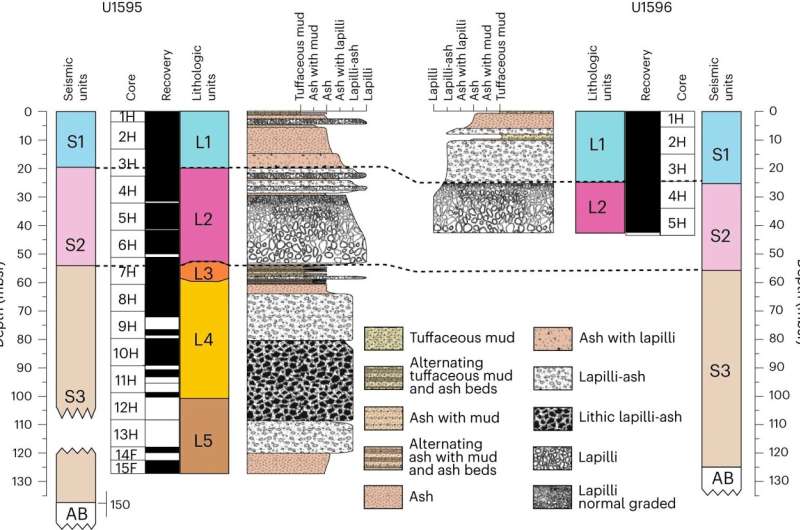This article has been reviewed according to Science X's editorial process and policies. Editors have highlighted the following attributes while ensuring the content's credibility:
fact-checked
peer-reviewed publication
trusted source
proofread
Scientific drilling unravels historical mystery surrounding Santorini volcanic archipelago

An international team of scientists co-led by Dr. Steffen Kutterolf from GEOMAR Helmholtz Center for Ocean Research Kiel has found evidence of a historical submarine eruption of the Kameni volcano on Santorini for the first time. In their paper, published today in the journal Nature Geoscience, they describe newly discovered pumice and ash deposits that support historical records of an underwater eruption in 726 CE.
The Greek island group of Santorini, famous for its picturesque white houses with blue roofs, is not only a popular tourist destination but also one of the most thoroughly explored volcanic archipelagos in the world. The islands, arranged in a circular pattern, form the rim of a sea-flooded caldera—the basin-shaped depression left by past eruptions.
At its center is the currently active Kameni volcano, whose peaks form the islands of Palea Kameni (Old Burnt Island) and Nea Kameni (New Burnt Island). The archipelago was formed after the devastating Late Bronze Age Minoan eruption some 3,600 years ago, when the previous volcano erupted vast amounts of ash and pumice and eventually collapsed, creating the iconic caldera walls of Santorini.
However, this wasn't the first caldera collapse in Santorini's history. "We now know of at least five such events within the last half million years," says lead author Dr. Jonas Preine, who completed his doctoral studies on the Christiana-Santorini-Kolumbo volcanic field at Universität Hamburg.
"Like other large volcanic systems, Santorini goes through caldera cycles. After a very large caldera-forming eruption, the new cycle is thought to begin with small but frequent eruptions as the volcanic system recharges. It then continues to mature, and eruptions become larger but less frequent before the system is ready to produce another caldera-forming eruption."
This typically occurs over periods of tens of thousands of years. Santorini is currently in a phase of magma accumulation but is still a long way from another caldera collapse. At this stage, no major explosive eruptions are expected.
However, the new seismic and drilling experiments and the subsequent geochemical analyses at GEOMAR challenge this hypothesis: an eruption in the early summer of the year 726 has been detected and reconstructed at various points in the drill cores from inside and outside the caldera.
Historical writings recount witnessing the sea boiling "as if heated by an incandescent furnace." Large blocks of pumice were ejected in such quantity that they covered the sea surface of the sea over a vast area and were carried by the wind to the coasts of Asia Minor and Macedonia.
It has been suggested that the sudden appearance of floating rocks in the Aegean Sea may have prompted Emperor Leo III of Constantinople, fearing divine displeasure, to impose iconoclasm, a ban on the display of religious symbols, which caused severe socio-economic instability in the Byzantine Empire. Aside from these historical accounts, concrete evidence for this eruption has been lacking until now.
Were the reports exaggerated? Or had the historical writers confused Santorini with another volcano?
The international IODP Expedition 398 "Hellenic Arc Volcanic Field" set out aboard the drilling vessel JOIDES Resolution to uncover remnants of this historical eruption. High-resolution seismic reflection data collected previously hinted at thick sediment layers of unclear origin.
Through drilling to depths of up to 300 meters, the team managed to gather evidence of the massive underwater eruption in 726 CE: The investigations revealed a layer of gray pumice and ash, up to 40 meters thick, unequivocally linked to a single eruption.
"This eruption must have taken place largely underwater within the flooded caldera, as almost no deposits from the eruption were found on land," says Dr. Jens Karstens, marine geophysicist at the GEOMAR Helmholtz Center for Ocean Research Kiel and second author of the study. "This is in line with the historical eyewitness reports."
Jonas Preine emphasizes that the 726 CE eruption was 30 times smaller than the famous Minoan eruption and says, "There is no indication that a similar eruption will occur in the near future."
Nevertheless, the new insights into Santorini's volcanic behavior have significant implications for hazard assessment, as the research suggests that even during the early phases of the caldera cycle, larger explosive eruptions can occur. Additionally, the results highlight the need for greater attention to submarine eruptions.
Preine says, "If we were unaware of the deposits of such a large eruption from a volcano as well studied as Santorini, we must assume that our global eruption records have a significant blind spot for submarine explosive eruptions."
Recognizing the potential for dangerous explosive eruptions in the early stages of caldera formation can be crucial in developing more comprehensive risk mitigation strategies.
More information: Jonas Preine, Hazardous explosive eruptions of a recharging multi-cyclic island arc caldera, Nature Geoscience (2024). DOI: 10.1038/s41561-024-01392-7. www.nature.com/articles/s41561-024-01392-7
Journal information: Nature Geoscience
Provided by Helmholtz Association of German Research Centres




















